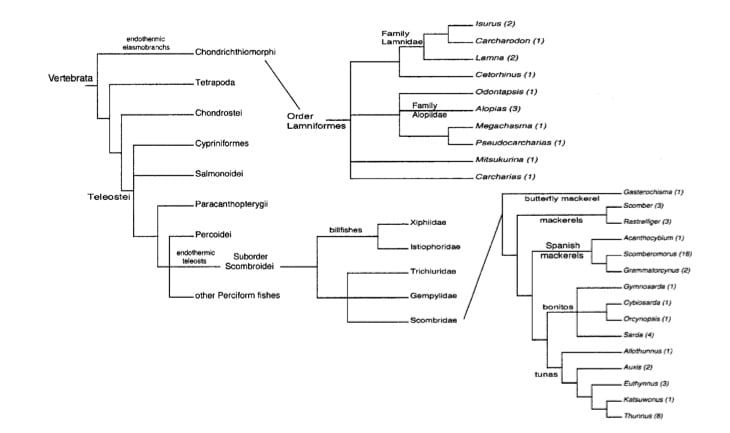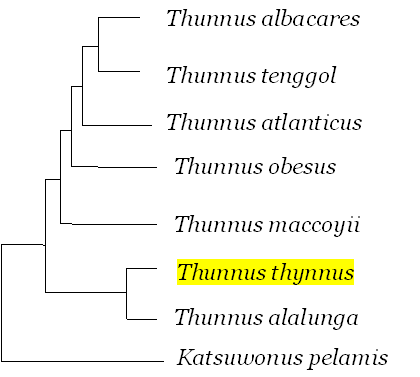Dickson, K. A., and J. B. Graham. “Evolution and Consequences of Endothermy in Fishes.” Physiol Biochem Zool 77 6 (2004): 998-1018. Print.
figure 1:figure 2:
 figure 3:
figure 3:
Viñas, J., & Tudela, S. (2009). A validated methodology for genetic identification of tuna species (genus Thunnus). PloS one, 4(10), e7606. doi:10.1371/journal.pone.0007606.
The Thunnus genus is a monophyletic group based on mitochondrial and nuclear DNA sampling and comparisons. There are eight recognized species within this genus, but the exact connections between them could still be debated due to molecular similarities of the species. This genus is incredibly similar morphologically, down to the fin location, number, and shape. All Thunnus species have the teardrop shape which allows for thunniform swimming. It is quite useful for their open ocean habitats and predatory lifestyles as it decreases water friction yet increases ability to go long-distance.
Thunnus thynnus (Atlantic bluefin tuna) have Thunnus alalunga (Albacore) as their closest relative. The main difference, because they are so morphologically similar, is the muscular nature of the fish. Albacore has much more lighter colored, white muscles (good for short, quick distances), while bluefin tuna have much more darker colored, red muscles in comparison (better for long distance cruising).
In terms of overall phylogeny, connections and exact ancestry could still be debated. With the three figures above, even within one study, depending on the methods you utilize it can produce diverging phylogenetic trees. Figure 1 is based on mitochondrial DNA control region, figure 2 on mitochondrial DNA cytochrome oxidase 1, and figure 3 on nuclear rDNA (ITS1). These figures do switch around basically when the speciation event would have occurred on the tree, but overall closely related species (ex. T. thynnus and T. alalunga) stay the same. As for the simplified phylogenetic tree, it relies on two clades: the bluefin group and the yellowfin group (T. atlanticus and up). That’s based on separate experiments on Thunnus DNA comparisons.
Citations:
Myers, P., R. Espinosa, C. S. Parr, T. Jones, G. S. Hammond, and T. A. Dewey. (2019). The Animal Diversity Web (online). Retrieved from https://animaldiversity.org.
Genus Thunnus. FishIDER. Retrieved from https://www.fishider.org/osteichthyes/scombridae/thunnus-spp/.
Viñas, J., & Tudela, S. (2009). A validated methodology for genetic identification of tuna species (genus Thunnus). PloS one, 4(10), e7606. doi:10.1371/journal.pone.0007606.


Leave a Reply